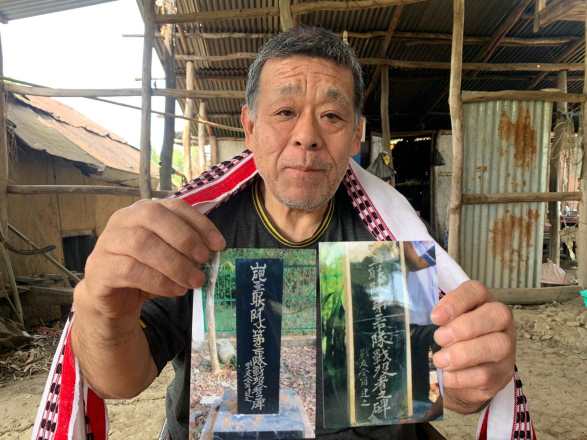Manipur has a long history of famous wars and battles and one such famous battle, which will forever remain etched in the history of this small Indian state, is the encounter between the Allied forces and Japanese Imperial Army at Red Hill (locally known as Maibam Lotpa Ching) on May, 1944 during World War II.
Since then, the battle site has been developed into a war memorial to honour the fallen heroes, especially the Japanese soldiers who fought valiantly for their country during World War II in Manipur. But the current infrastructure condition and prominent inscription mistakes found at the Japanese War Memorial also called Imphal Peace Museum has sparked an outcry from the Japanese people.
Speaking to Imphal Free Press at Samushang, Imphal, general secretary of Indo-Japan Friendship Association Miura Mamoru, who is conducting a field survey of Japanese artifacts left behind during World War II in Imphal, informed that the Japanese inscription mistake was found at the pillar located near the memorial shrine of Japanese War Memorial site, Maibam Lotpa Ching.
Mamoru stated that he could not understand the Japanese inscription etched in the pillar. He maintained that such a careless display at the memorial site showed lack of empathy and compassion for another culture.
“I came across the inscription mistake during a recent visit; I am a Japanese, but even I could not understand what the Japanese script inscribed in the pillar,” he said.
Mamoru informed that the original inscription on the pillar showed the name of the Japanese soldier team and their leader.

(Old incription at the Japanese War Memorial pillar, Imphal, Manipur (PHOTO: IFP)
Mentioning that such careless mistakes hurt the national sentiment of the Japanese people, Mamoru recalled that such mistakes were not found in the original pillar. The original pillar was there the last time I visited Imphal four years ago, he added.
The general secretary stated that it was a shame for Manipur and Japan to display such a prominent mistake at an international war memorial site.
“The original pillar was constructed along with the shrine and was completed on December 12, 1977; the inscriptions on the shrine and the original pillar were made with the help of a Japanese man called Makino Zaishi,” he said.
He extended gratitude to the Manipur government for renovating the old pillar and the shrine; however, he noted that it would have been better if the government had consulted with the Japanese authority before taking up such a move.
Highlighting that the work quality and material used for the renovation were poor, Mamoru pointed out that the date and year of inscription were also missing.
“It is Japanese rule to write the date and year of inscription on such historic monuments; also it would be thoughtful to add the English and Manipuri translation alongside the Japanese inscription so that visitors from every corner of the world could understand,” he added.
The general secretary also mentioned he had approached the Manipur Tourism Department about the matter. A written application about the issue will be delivered soon, he said.
Concerning the WWII Japan War Memorial Museum, Mamoru expressed discontentment with the maintenance of the museum infrastructure. The museum is not even two years old but some portions of the museum such as the pavement leading to the museum has started to break, he added.
“It has been nearly 80 years since the war took place but what is important now is to properly maintain such historic places for future generations,” he stated.
Mamoru also expressed disappointment with Japanese authorities for not taking any maintenance responsibility. Only providing funds is not enough; Japanese authorities also need to take a proactive role in the maintenance, he added.
It may be mentioned that the museum was made with a united fund from the Manipur government, the Nippon Foundation and the Second War World Imphal Campaign Foundation in 2019.
He urged both the Japanese and Manipur government to properly maintain such international platforms and stated such measures will aid in strengthening the bond between the countries.
Miura Mamoru further appealed for the inscription mistake and museum site to be fully corrected and properly renovated before the Sangai festival, 2023. It will hurt the sentiments of the Japanese and foreign delegates visiting Manipur during the festival to see such careless mistakes, he added.
He maintained that even though the place is small, it holds a huge sentimental space within the Japanese people.